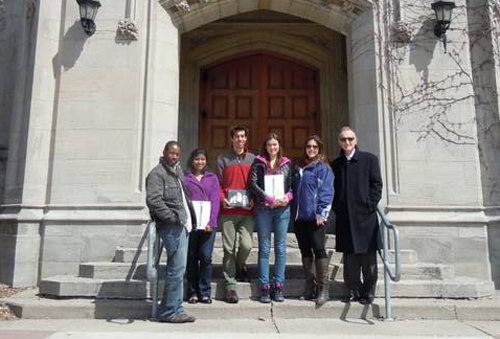
Five years ago, University of Guelph students voted to contribute $10 per term toward projects that would conserve energy on campus.
Dan Maclachlan, director of design, engineering and construction in the University’s Department of Physical Resources, says the student referendum “impressed the hell out of Peter Love, who was Ontario’s chief energy conservation officer at the time.” Love had failed to convince the students at his alma mater, the University of Toronto, to make just a $2 contribution.
The money U of G students contribute to energy conservation initiatives is matched by the University.
Most of the students who voted in the Guelph referendum have now graduated and moved on. But the contributions continue and so does the Energy Conservation Working Group (ECWG) that was created to oversee how the money would be used. Maclachlan and Jessica Carter, the Central Student Association academic and university affairs commissioner, are the 2011/12 co-chairs. Annual reports about the committee’s work are provided to the University’s vice-president of finance and administration.
After five years, ECWG members wondered if student priorities might have changed too. “We decided it was time for a survey,” says Maclachlan. “Were students still interested in energy conservation? Were they happy with what the committee was doing and how their money was being spent?”
The survey was conducted by email in January, and students who completed the survey had their names placed in a draw to win an iPad or Kobo vox. “I was very surprised that so many students responded,” says Carter. “We had more than 800 surveys completed. The students told us they really appreciated being asked.”
The response shows that energy conservation, environmental issues and sustainability continue to be of significant concern for U of G students. “Students are generally well-informed on these issues,” says Maclachlan. However, they were not as well-informed about the work of the ECWG: “We seem to be flying under the radar.”
When projects funded by the program were listed in a survey question, the majority of students felt positively about them, but many said they had not been aware of these before doing the survey. They also said they would like to see “reducing environmental impact” as the top priority in choosing projects for the future.
Clearly, though, increasing student awareness of the committee’s work is another important priority. ECWG members know it’s important to make their projects visible, but that isn’t always easy to achieve, says Carter. “When we change lighting, for example, people don’t always notice. We’ve installed some signs at the sites of various projects explaining what’s been done, but we’re contemplating new ways to let people know what we’re doing: Twitter, Facebook, a webpage.”
This summer’s project will be a major ventilation retrofit in the MacNaughton Building. It’s a building where the number of people inside can vary dramatically, but until now the volume of air for heating and cooling has been kept constant all year round. This summer, U of G will install a new variable system that will automatically increase or decrease the air flow depending on actual need within the building.
You probably won’t notice the difference, but that’s the whole point, say Carter and Maclachlan. This project will be saving energy while still getting the heating or cooling needed to keep the building’s occupants comfortable.
While the retrofit will cost about $1.3 million, Maclachlan expects it will pay for itself within 10 years. Any financial incentives received due to energy savings are returned to the fund to be used on future projects. Energy conservation projects are important for U of G, adds Maclachlan, because “we are an energy-intensive university. We have the veterinary hospital and research labs that consume a lot of energy, often through the nights and over weekends as well.”
A campus-wide energy feasibility study will also be completed this summer and is expected to provide a list of options for energy-saving projects for every building. That’s information the ECWG can use to make future decisions. “The survey has given us lots of great information about student priorities to guide decisions for the next five years,” says Carter. “With the information from the energy feasibility study, we’ll be in a great place to move ahead.”
She adds that ECWG never loses sight of the fact that the money comes from the students, and that the students’ priorities should be at the top of the list when projects are chosen. “I’m excited to see what’s going to be accomplished in the next few years.”